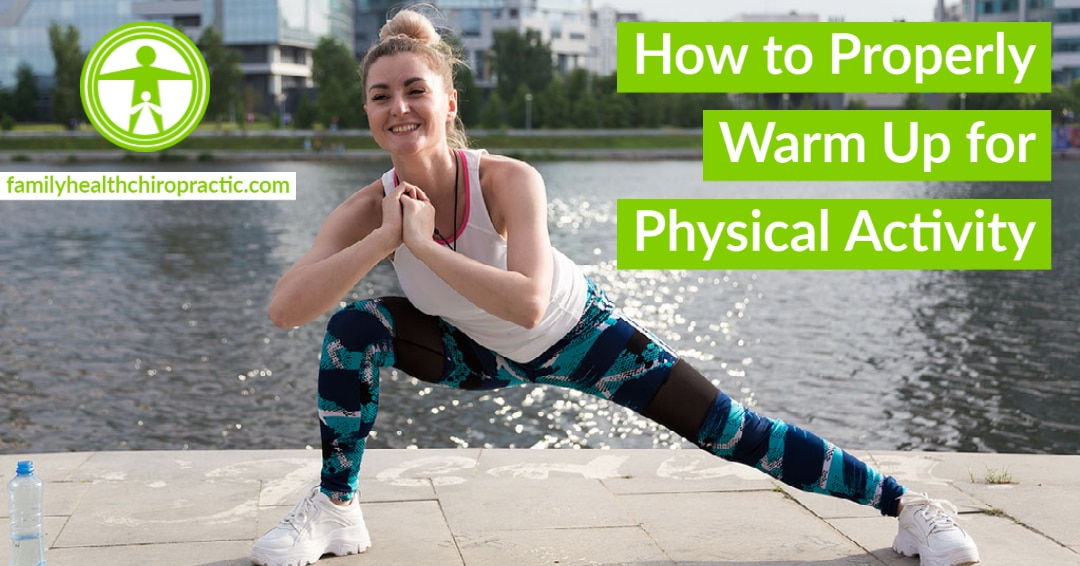The Importance of Warming Up, Not Stretching
Previously, we discussed different types of stretching as well as how to stretch safely.
In this article we are going to share additional information regarding dynamic stretching and how it can impact your performance.
When done correctly, a warm-up enhances your physical performance by helping you limber up and get blood flowing to your muscles.
Current evidence suggests that the type of stretches you do and more specifically, when you do them, can help or even hurt your body.
Runners, for example, are known to warm up with a string of static hamstring and quadriceps stretches. Static stretches are the type of stretches we do when we bend over and hold a position for a few seconds or minutes.
While static stretching can be useful in terms of improving flexibility and mobility; it could hinder performance.
Current studies advise skipping pre-sport static stretches, which have been shown to undercut performance in activities that require running, jumping, and other explosive movements.
A 2013 meta-analysis of more than 100 studies on different types of athletes showed that doing static stretches before sports cut muscle strength by roughly 5% and explosive power by 2%. While this is not a major difference, it’s certainly enough to affect performance.
In a 2019 study, people who performed static stretches immediately before doing resistance training executed fewer reps during their workouts than those who did no stretching before working out, possibly because their muscle fibers were fatigued and may not have contracted as efficiently. And over the course of 10 weeks, the no-stretching group built more muscle than the stretching group, probably due to the fact that the no-stretching group lifted more weight – yet another reason to save static stretching until after your workout.
All that said, it seems apparent that holding static stretches multiple times for 30 seconds won’t help your game, but should be incorporated to improve flexibility. In fact, it’s particularly detrimental to the hamstrings before a run, or to calves before trying to jump.
So instead of the stereotypical types of stretching you can do, try warming up muscles and bringing joints through a range of motion with dynamic movements, including dynamic stretches.
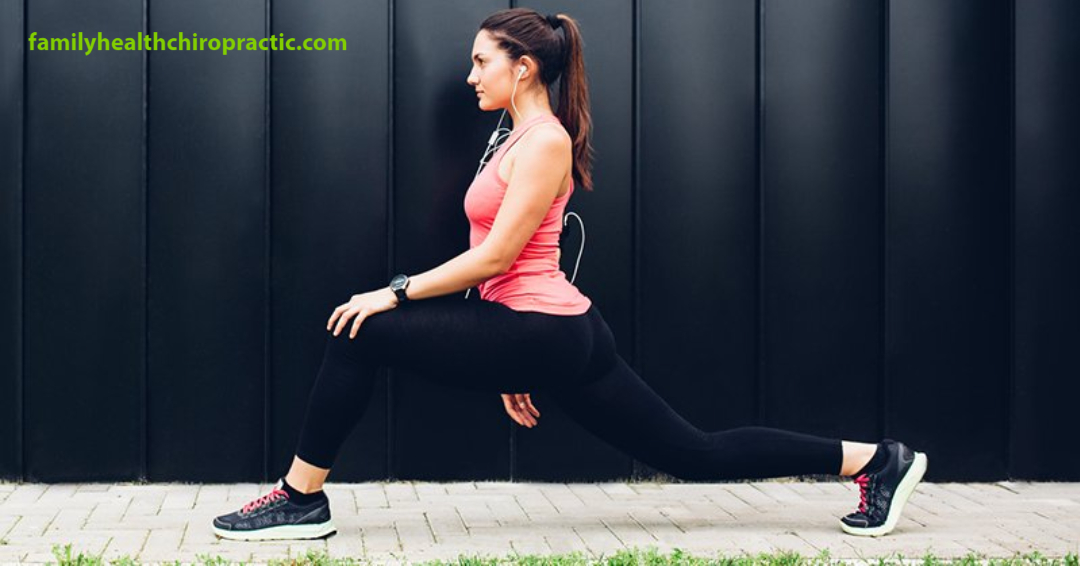
Warming Up Muscles & Waking Up Nerves
A growing field of research in physical performance suggests neuromuscular training may have a role to play in sports that require jumps, quick stops, and sudden shifts in direction, such as basketball, soccer, and skiing.
A burgeoning field of research suggests neuromuscular training may have a role to play in sports that require jumps, quick stops, and sudden shifts in direction, such as basketball, soccer, and skiing.
Typically, neuromuscular training amounts to a pregame warm-up involving stretching, strengthening, and balance exercises, plus drills designed to enhance agility and reinforce good form when stopping short, changing direction, and landing.
The movement patterns chosen for neuromuscular training echo those used in a particular sport to facilitate coordination – or, as some trainers put it, movements that “wake up” the nerves and brain.
A 2012 review of studies in BMC Medicine found that consistently applying such strategies for three months or more reduced lower-limb injuries in young, amateur, and female athletes and in military recruits of both genders.
According to a recent review and meta-analysis of nine studies, a specially designed neuromuscular warm-up program for soccer players reduced risk of injury by 20% to 50%.
This type of training has also been shown to reduce the risk of knee injuries in females, who are more likely to suffer from this type of injury for a variety of reasons, including their anatomy.
At the most basic level, Chiropractic adjustments enhance the connections between your brain (cerebellum) and motor units (muscles).
One study shows that a single session of chiropractic manipulation results in a 64.2% increase in strength of weak plantarflexion muscles. Another study shows that chiropractic care increases reaction time by 25% in healthy individuals and 19% in individuals with chronic pain.
These changes were not created by a direct effect on the muscle fibers or spinal nerves, but the cortex and cerebellum via one single chiropractic adjustment.
The role chiropractors play in muscle health and physical performance is two-fold:
- A chiropractic adjustment creates neuroplastic changes that can increase strength and reaction time as well as decrease pain and dysfunction.
- By correcting and improving your posture and training your body to increase strength, flexibility and proper movement patterns.
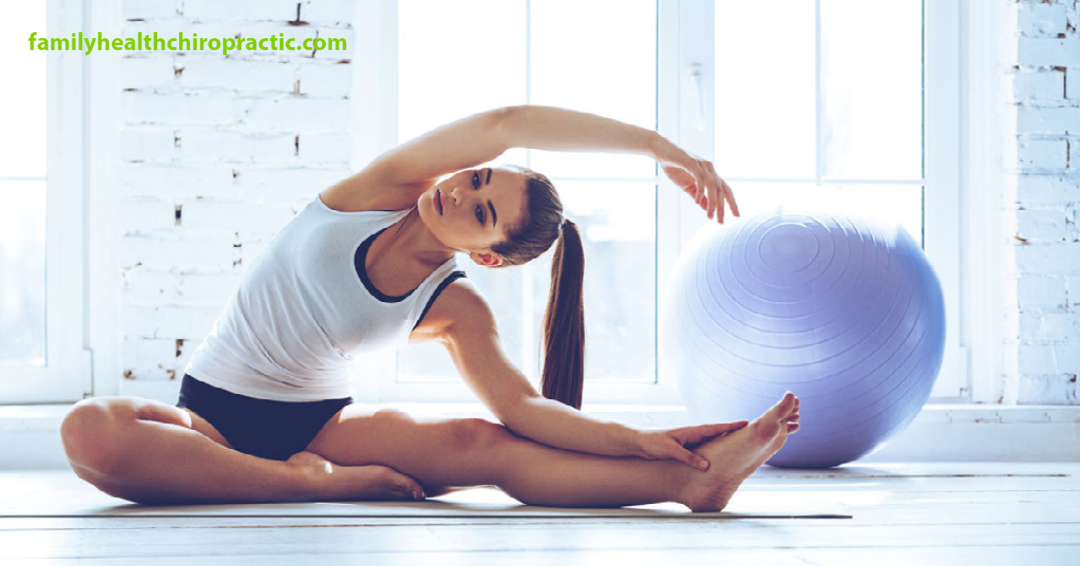
How to Start Practicing Dynamic Stretching
Unlike many neuromuscular training programs designed for athletes, a general dynamic stretch routine is designed for the widest possible audience.
A good dynamic stretching routine should move your body in three ways: forward and backward, side to side, and through rotations.
The goal is to loosen up joints to increase your range of motion and warm up tissues throughout the body, which helps cells to get the oxygen and energy demanded by any physical endeavor.
Perform each of the following six dynamic stretches 10 to 20 times, followed by four arm sweeps. During each dynamic stretch, go from smaller movements to larger movements, to gradually increase range of motion.
Shoulder Rolls
Stand up straight with your feet hip-width apart and arms at your sides. Roll your shoulders up, back, and down. Your thumbs point forward as you start the move. Palms point forward, elbows slightly bent, as you finish each shoulder roll.
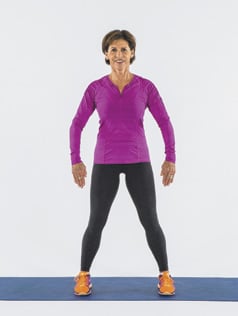
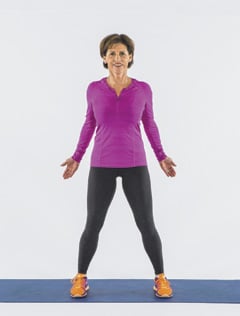
Overhead Reach
Stand up straight with your feet hip-width apart. Reach toward the ceiling with your right arm, while shifting your weight from your right foot to your left foot and tapping the toes of the right foot. Repeat on the left.
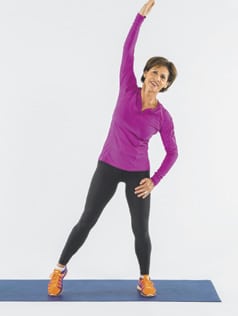
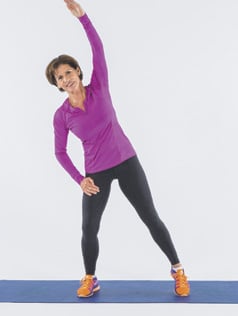
Torso Rotation with a Reach
Stand up straight with your feet hip-width apart. Reach toward the left wall with your right arm and then the right wall with your left arm, while shifting your weight with each change of direction. Tap your toes with each shift.
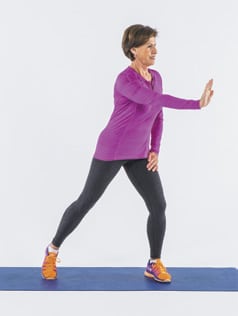
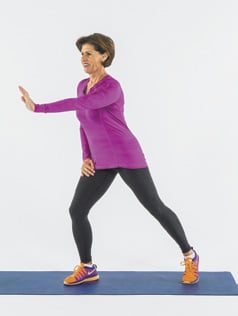
Hamstring Curls
Stand up straight with your feet hip-width apart. Alternately bend your right knee and then your left, bringing your right foot and then your left foot toward your buttocks. Press your arms backward as you do so.
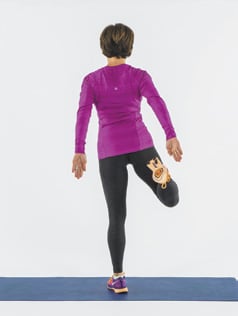
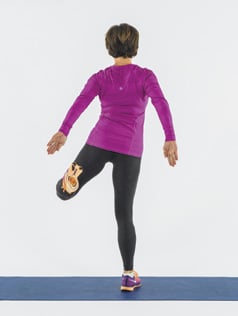
Shallow Side Lunges
Stand up straight with your feet in a wide stance, toes pointing forward. Alternate shallow side lunges to the right and the left, hinging forward at the hip and bringing both hands to your upper thigh on the lunge.
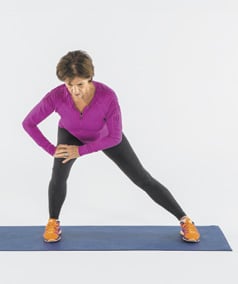
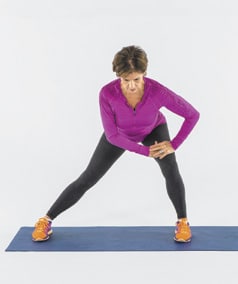
Knee Lifts
Stand up straight with your feet together. Lift your right knee and then your left knee, touching both hands to the knee being lifted. For a more challenging dynamic stretch, lift your knee high enough to grasp the top of your shin with your hands and pull your leg gently in toward your body, then release it.
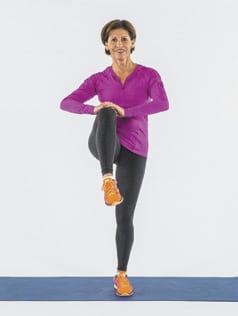
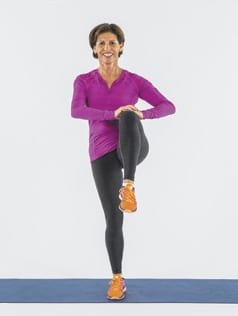
Repeat the above sequence of dynamic stretches for about five to eight minutes, rolling each stretch into the next one. Start over again as needed to fill the time you’ve allotted.
You can always add a sports specific move to the routine: for example, a golf or tennis swing, or a series of shallow to deeper jump squats to ready the body for basketball. If you do this, go slowly and deliberately through the first few reps, then pick up your pace, always focusing on correct form.
Finally, if you have trouble with balance, you can put one hand on the back of a chair or a counter. It’s even possible to do most of these movements while seated.

Dynamic Stretching Improves Performance
Dynamic stretches are active movements where joints and muscles go through a full range of motion. They should be used to help warm up your body before exercising.
Dynamic stretches are meant to get the body moving. The stretches aren’t held for any length of time as in static stretching.
Dynamic stretches include movement, such as lunges with a torso twist. Static stretches, on the other hand, are where muscles are extended and held for a period of time.
The next time you exercise or play sports, try adding dynamic stretches rather than static stretces to your warmup. You may find your body feels more energized, stretched out, and ready to power you through your workout.

